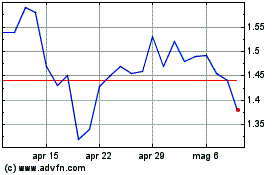Fannie Mae's Profit Halved
05 Novembre 2015 - 2:50PM
Dow Jones News
Fannie Mae said profit was halved in the third quarter, as
declines in long-term interest rates hurt the value of the
mortgage-finance company's derivatives.
Fannie Mae said it expects to send the U.S. Treasury Department
$2.2 billion in December.
The company reported a profit of $1.96 billion for the third
quarter, down from $3.91 billion a year earlier.
The decline was driven by $2.59 billion in fair-value losses in
the quarter, compared with a loss of $207 million in the
year-earlier period. The losses stem from changes to the value of
the derivatives Fannie Mae uses to manage risk, triggered by
decreases in long-term interest rates.
Rival Freddie Mac on Tuesday posted its first quarterly loss in
four years, also driven mainly by an accounting discrepancy
involving the derivatives the company uses to protect against
interest-rate changes. The derivatives are recorded at market value
even though some of the hedged assets aren't, which resulted in a
discrepancy that Freddie said caused a $1.5 billion hit to
earnings.
Over the past few years, rising home prices and lower mortgage
defaults have bolstered the profits of Fannie and Freddie.
Now, those benefits are receding, making the companies more
susceptible to the need for taxpayer help should the housing market
turn south and as the government requires them to wind down their
capital reserves.
The companies remain caught between shareholders and
civil-rights groups who want to see them freed from government
control, a White House that believes the current system is broken,
and a Congress that can't come to agreement on what the future
system should be.
The government took over Fannie and Freddie in 2008 and
eventually infused them with $187.5 billion in bailout money. Since
then, the companies have become highly profitable, paying out $239
billion in dividends.
Fannie Mae said it will have sent the Treasury $144.8 billion
after the December payment.
In the third quarter, Fannie Mae's net interest income, which
includes fees from backing mortgages, grew to $5.59 billion from
$5.18 billion a year earlier, driven by higher guaranty fees.
In recent years, a larger portion of Fannie's net interest
income has been made up of guaranty fees, rather than interest
income earned on its retained mortgage portfolio assets. Fannie
said the shift reflects guaranty fee increases implemented in 2012
and shrinking of its retained mortgage portfolio.
Fannie Mae has said it expects its earnings this year and beyond
to be "substantially lower" due to the drop in income from its
retained mortgage portfolio assets, lower income from resolution
agreements, and lower credit-related income.
Write to Chelsey Dulaney at Chelsey.Dulaney@wsj.com
Subscribe to WSJ: http://online.wsj.com?mod=djnwires
(END) Dow Jones Newswires
November 05, 2015 08:35 ET (13:35 GMT)
Copyright (c) 2015 Dow Jones & Company, Inc.
Grafico Azioni Fannie Mae (QB) (USOTC:FNMA)
Storico
Da Mar 2024 a Apr 2024

Grafico Azioni Fannie Mae (QB) (USOTC:FNMA)
Storico
Da Apr 2023 a Apr 2024
